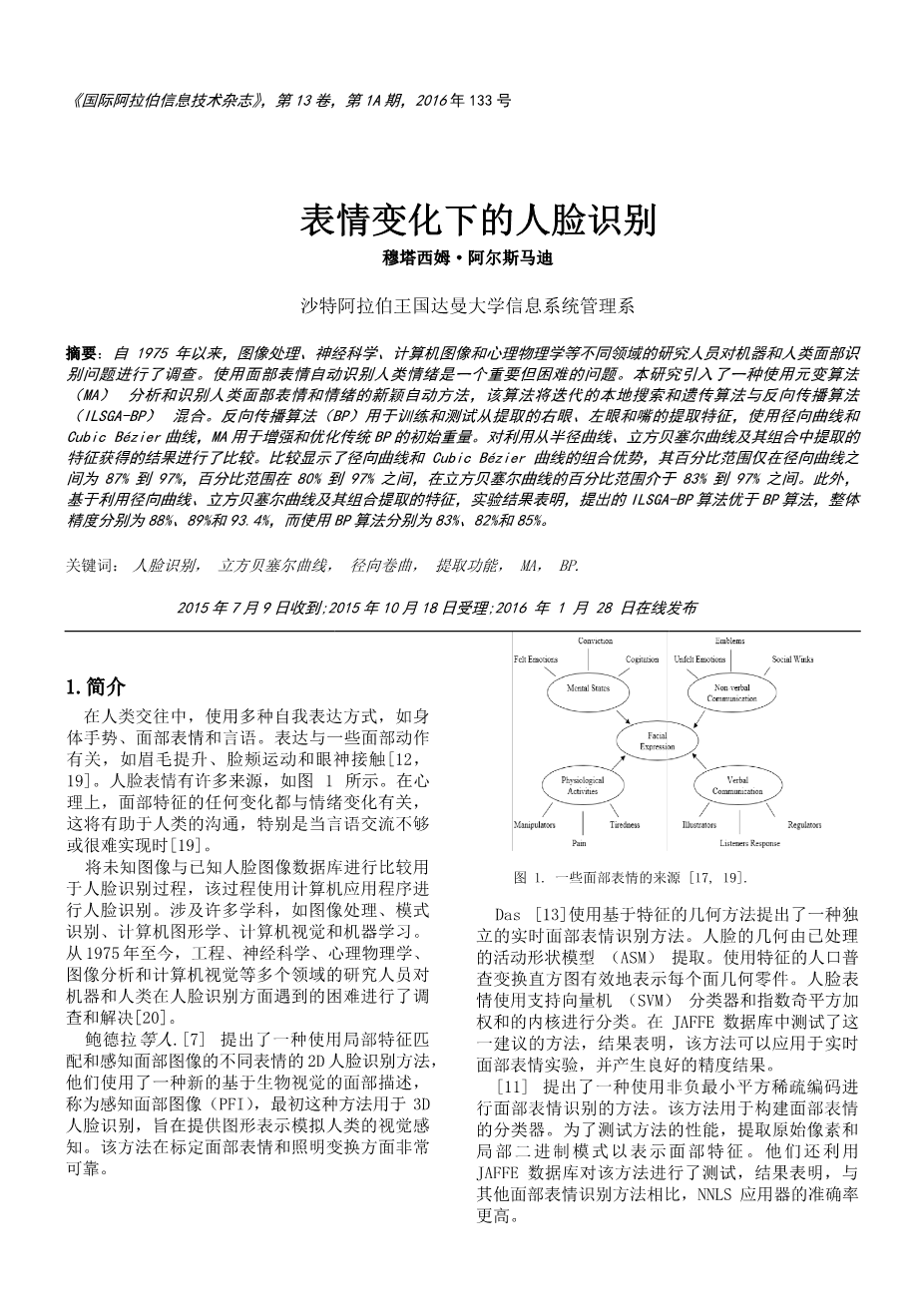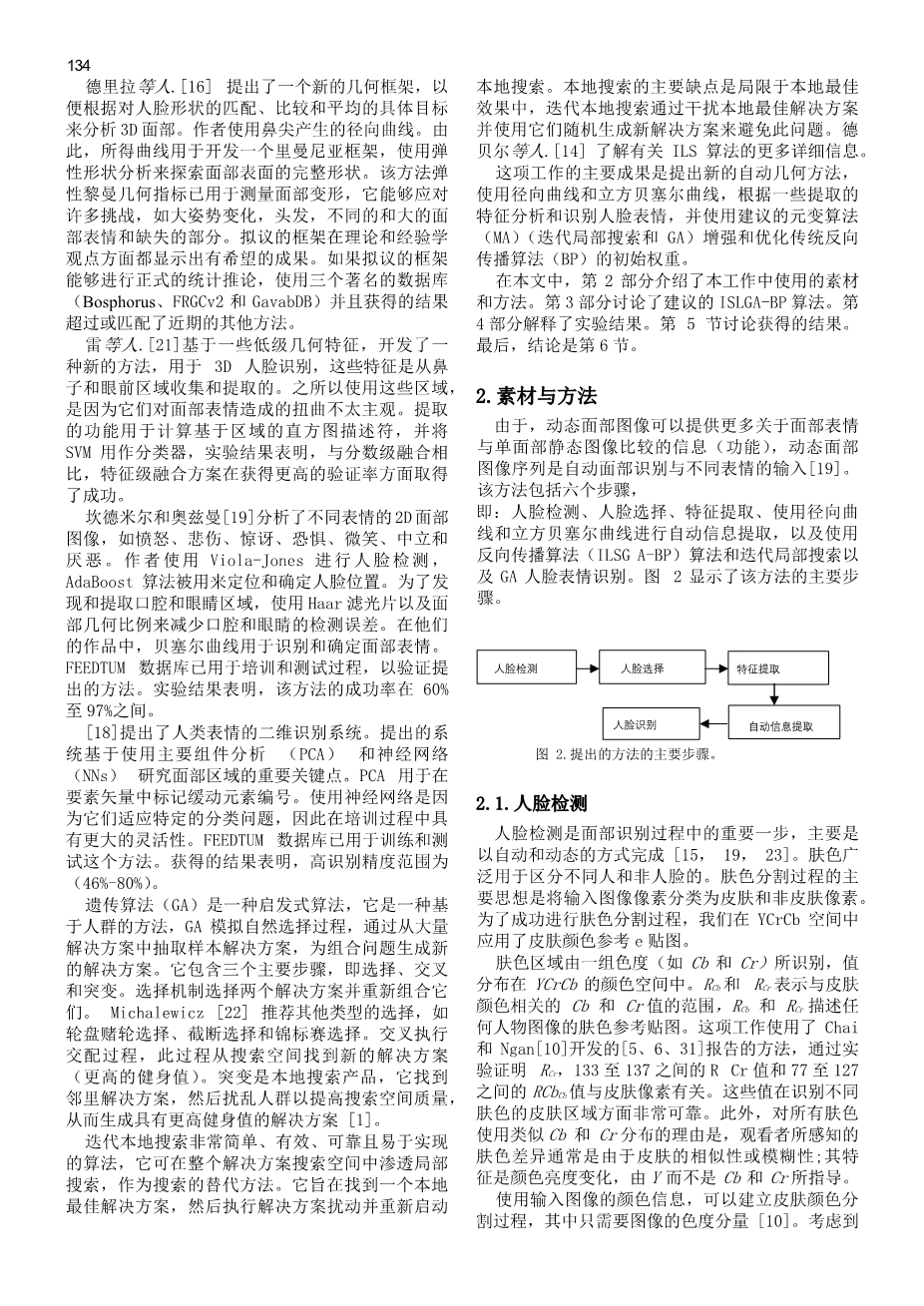Facial Recognition under Expression
Mutasem Alsmadi
Variations
Department of Management of Information System, University of Dammam, Kingdom of Saudi Arabia
Abstract: Researchers in different fields such as image processing, neural sciences, computer programs and psychophysics
have investigated number of problems related to facial recognition by machines and humans since 1975. Automatic
recognition of the human emotions using facial expression is an important, but difficult problem. This study introduces a novel and automatic approach to analyze and recognize human facial expressions and emotions using a Metaheuristic Algorithm (MA), which hybridizes iterated local search and Genetic Algorithms with Back-Propagation algorithm (ILSGA-BP). Back-
propagation algorithm (BP) was used to train and test the extracted features from the extracte right eye, left eye and mouth
using radial curves and Cubic Beacute;zier curves, MA was used to enhance and optimize the initial weights of the traditional BP. FEEDTUM facial expression database was used in this study for training and testing processes with seven different emotions namely; surprise, happiness, disgust, neutral, fear, sadness and anger. A comparison of the results obtained using the extracted features from the radial curves, Cubic Beacute;zier curves and the combination of them were conducted. The comparison shows the superiority of the combination of the radial curves and the Cubic Beacute;zier curves with percentage ranges between 87% and 97% over the radial curves alone with a percentage ranges between 80% and 97% and over the Cubic Beacute;zier curves
with a percentage ranges between 83% and 97%. Moreover, based on the extracted features sing the radial curves, Cubic
Beacute;zier curves and the combination of them, the experimental results show that the proposed ILSGA-BP algorithm
outperformed the BP algorithm with overall accuracy 88%, 89% and 93.4% respectively, compared to 83%, 82% and 85% respectively using BP algorithm.
Keywords: Face recognition, cubic beacute;zier curves, radial curves, features extraction, MA, BP.
Received July 9, 2015; accepted October 18, 2015; published on line January 28, 2016
- Introduction
In human interaction, diverse ways for self-expression are used, such as body gestures, facial expression and speech. Where speaking is connected with some facial movements such as eyebrow-raise, cheeks-movements
originally this approach was used for 3D face recognition, it aims to give a graphical representation simulates the visual perception by human. This method was robust in affixing the facial expressions and lighting transformations.
and eye-contact [12, 19]. The face expressions are
connected with multiple sources as shown in Figure 1.
Psychologically, any change in the face features is
connected with emotional changes and this will help in the human communication especially when the verbal communication is not enough or very difficult to be achieved [19].
Comparing unknown images with databases of known face images are used for face recognition process which is performed using computer application for face identification. Many disciplines are involved, such as image processing, pattern recognition,
Figure 1. Some facial expressions sources [17, 19].
computer graphics, computer vision and machine
learning. From 1975 until now, researchers in several Das [13] proposed an individual independent real-
fields such as engineering, neural
sciences and
time facial expression recognition method using
psychophysics, image analysis and computer vision have investigated and tackled number of difficulties regarding to face recognition by machines and humans [20].
Boughrara et al. [7] proposed a 2D face recognition
Feature-based geometrical approach. Geometry of the face is extracted by the adapted Active Shape Model (ASM). Every face geometry part is efficiently represented using Census Transformation histogram of features. The face expressions are classified using
approach with different expressions
using the local
Support Vector Machine (SVM) classifier and
features matching and perceived facial image, they used a new biological vision-based facial description which is called Perceived Facial Images (PFIs),
exponential chi-square weighted merging kernel. This proposed approach was tested on JAFFE database, the results show that this approach can be applied on real-
time facial expression experiments and produces good accuracy results.
An approach was proposed by [11] for facial expression recognition using non-negative least squares sparse coding. This method was utilized to build a classifier for facial expressions. In order to test the performance of the proposed approach, the raw pixels and the local binary patterns are extracted to represent the facial features. They also used the JAFFE database for testing the proposed method and the results show that NNLS approach obtained better accuracy rates compared with other facial expression recognition methods.
Drira et al. [16] proposed a new geometric framework in order to analyze 3D faces, based on specific aims of matching, comparing and averaging of faces shapes. The authors used the radial curves arising from the nose tip. Thus; the obtained curves were used to develop a Riemannian framework using elastic shape analysis for exploring full shapes of facial surfaces. The proposed method elastic Riemannian metric has been used for measuring facial distortions and it was robust to many challenges such as large pose variations, hair, different and la
剩余内容已隐藏,支付完成后下载完整资料


英语译文共 8 页,剩余内容已隐藏,支付完成后下载完整资料
资料编号:[237421],资料为PDF文档或Word文档,PDF文档可免费转换为Word


